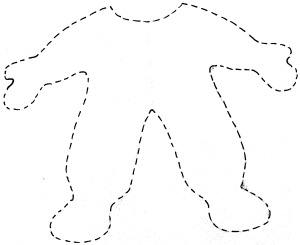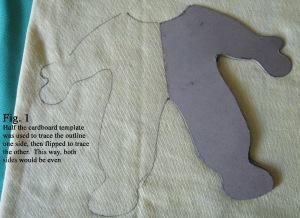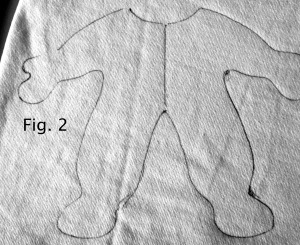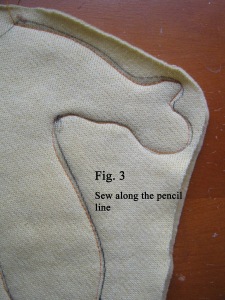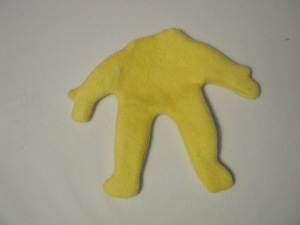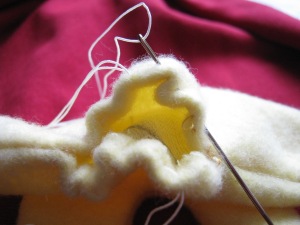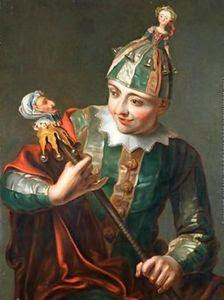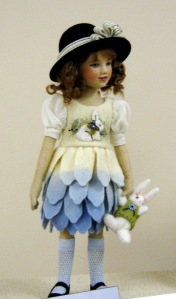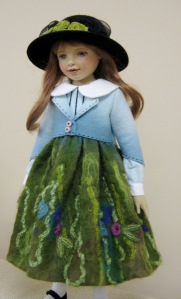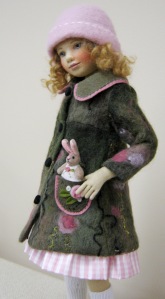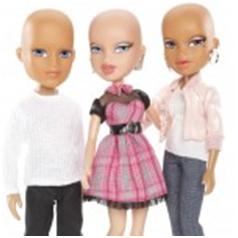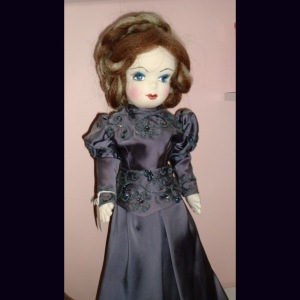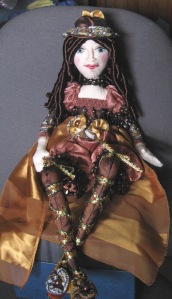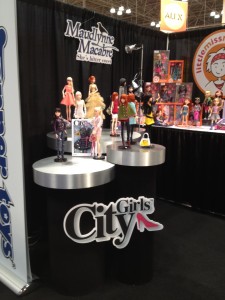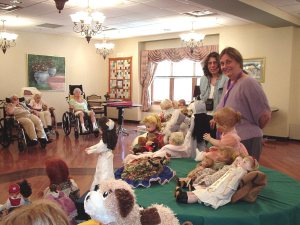The following are excerpts of emails and conversations with Linda Lipfert White, the granddaughter of famed doll sculptor, Bernard Lipfert. I was able to visit Linda who now lives in the Lipfert ancestral home in Westbury Long Island, New York during the summer of 2011.
Bernard Lipfert sculpted and creating dolls for most of the prominent doll and toy manufacturers in American from the 1920’s-1960’s including such successful dolls as Patsy, Shirley Temple, DyDee, and many others. Many articles were written about Bernarnd Lipfert and his dolls which, looking back is surprising as artists working for the large doll companies were not affored much credit for their creations.
Bernard Lipfert was born in the Thuringian region of Germany in 1886. After an art education, he emigrated to the United States in 1912. He married twice and had a son Max Lipfert, Linda’s father. Having raised a family of her own, Linda spends some of the time she is not attending to the grand-kids in reconstructing the life of her grandparents, remembering the very human side of the man who has been dubbed the “Dean of American Dollmakers.”
Next year it will be 100 years since he came to this country and I still wish I had a bigger picture of his life. He came from a family of toy makers, in Sonneberg… He was one of eight children. I was given to understand that it was his brother who sent him to art school Another picture places him in Ohrdorf, prior to emigration. He came to this country to avoid the draft in Germany; his brother had emigrated prior to him.
He came over initially in 1912, returned to Germany and came back with Frieda,(his first wife) in 1914. My father (Max Lipfert) was born in Brooklyn in 1915 by a midwife. They returned to Germany in 1920…to seek treatment for Frieda who suffered from TB. They lived with my grandmother’s family in Schabhausen,Germany.
 Lipfert as a young man on right. Frieda, his first wife seated in front of Elsie, Lipfert’s second wife.
Lipfert as a young man on right. Frieda, his first wife seated in front of Elsie, Lipfert’s second wife.
After Frieda died, my grandfather and Elsie (his second wife and Frieda’s sister) returned to US, 1923. Max(my father) returned to the US in 1926, on a ship by himself. 1930 census found them all in Brooklyn. His (Lifpert’s) move in 1941 to Westbury as I remember was in part because of the damp basement he worked in. As long as I can remember he and my grandmother would go to FL in the winter after the rush of preparing for the toy show finished. The last doll that he (Lipfert) made, that went into production was when he was in his late 70’s.
Lynn: Did your grandfather ever apply for a patent or copyright any of his doll creations?
Linda: I ask my mother how come he never copyrighted his stuff and she said “It was too much to do…” I mean he really liked to do his work…he had a patent for a doll that talked…that was in 1934 but he really didn’t want to get into royalties and all that stuff.
If he needed extra money he went to another manufacturer and said, ‘Do you want a variation thereof,’ and then he would do it and then he’d make various sizes… that again he would be charging for.
Lynn: And of course they all liked the basic work he had done, like the Patsy doll…
Linda: Well that’s why I brought out this book (shows Lynn the Composition doll book I have a list of dolls from this book
But I can tell you just visually which ones were his because either I have in the attic or I have seen them in the house at some point…but her never displayed anything …. I am refurbishing what was his office and he had two chairs a small liquor cabinet and a card table because they always played cards and then he had a huge slab of marble that was his table.
Lynn: That’s what he worked on.
LINDA: Yes that was his table and he had a florescent light, but he usually counted on daylight…he did like to work at night and that was it…he had a place for his plaster…he mixed his own plaster…he didn’t have any helpers.
LYNN: Did he ever do any lady fashion dolls…looks like most of them were children?
LINDA: …No, not only children…Revlon…I don’t know if Barbie was a little bit after Revlon?
LYNN: Revlon was about 1952 and Barbie came out in 1959
LINDA: So he was the first one with dolls with boobs and she had earrings…I have one upstairs. He did Revlon…he did Betsy McCall…which is more a girl doll.
And his bridal dolls for Madame Alexander they weren’t really ladies…you’d have to see the one upstairs…its not a girl …its not a woman; she doesn’t really have a chest…its kind of an anjenou.
LYNN: Are you aware that you were the model for the Baby Coos doll?
LINDA: I heard that from my mother; I mean he tried to model my sister too, but she was very small from birth…she was five pounds at birth so he came over a couple to time to sketch her but I don’t think that he ever used her. It’s funny because I asked my mother about Amosandra because if you go into the articles they give a name of a lady who did illustrations…and she illustrated (Linda: is referring to Ruth Eleanor Newton who is credited with the design for the Amosandra doll.)
So sometimes you would have a concept; then they had the person who would draw the concept ; then you would have the modeler who would put it into a three dimensional final product; then there would be modifications. They asked the lady (Newton) to draw what they wanted and then he (Lipfert) sculpted it .
Lynn: I am not familiar with that doll?
Linda: Amosandra was a baby of Amos from the Amos and Andy show…they had a baby on the program in fact that was …I have a picture of me… I was in first grade and I am front and center holding an Amosandra doll and that’s the doll I loved to play with.
Lynn: He sculpted a lot of character dolls.
Linda: All kinds of dolls…he did Pebbles & Bam Bam… he did Campbell Kids, Patty Playpal, going back to 1924 Tynie Baby Patsy was 1928 Dydee was 1933, the Qunituplets, Shirley Temple, Judy Garland, Babs Baby Food, Ginny doll, Betsy McCall…he did the Ricky doll from I Love Lucy.
And they were taking pictures and you see they gave him photographs …when he was doing…you see this was in Brooklyn but they gave him photographs of Shirley Temple
LYNN: So this is actual photograph he was working from?

LINDA: Apparently it was her (Temple’s) mother who picked him.
So what happened was , this is the grandmother I knew… this was her sister my father’s mother so she was a little older she is like 15 in this picture but she married my grandfather…he came over first then he brought her over and she contracted TB so after WWI, I think 1920 they went back and tried to get her treatment in Switzerland and she died Then he got caught up in the Weimar Republic where he was worth nothing and he stayed on the farm to help and then and I don’t know who specifically, whether it was from Horsman, or somebody else who had brought him over but they paid for his fare
LYNN: Do you know her name (grandmother)
LINDA: Her name was Frieda
Lynn: So he married the sister
Linda: Well she was the only one left…the sister and the grandmother were on the farm and in fact that particular grandmother left my father the farm which is in East Germany and he just relinquished the land It didn’t seem to pay to go back…
LYNN: Do you have any contact with their families or anyone else over there?
LINDA: No not anymore…his niece used to come over and she was… she looked like “Brunhilda”…and she used to come over every so often…maybe three or four times. This is in Brooklyn…this the grandmother that I knew…this is my grandfather….they had like a walk up and they had a full window here…this is where he would work; he would work on the first floor and the rest of the house…he always had a hat…he had thinning hair..so here he had his hat on…a fedora before 1930’s
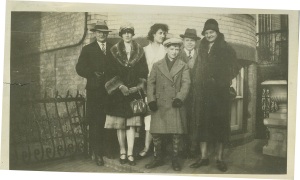
My father came over in between 1928 and 1930
Here is some other pictures: This is Sonneburg this the town he came from …it’s Thuringinwald…its very Bavarian one of his grandmother’s owned a mill with a water wheel…my mother has the painting he did when he was 16 of the watermill…but this is the town…
LYNN: Did you ever go on vacations with him…there are references to his going to Florida and the Adirondacks.
Linda: They went up to Vermont NH…They used to go to Saratoga a lot. He liked the horses, so a lot of times he would walk to the raceway over here (Roosevelt Field) and he didn’t bet much, but liked to watch the horses run…in Florida they went to Hialeah but that did not start until the 1950’s
LYNN: Did they have a house down there?
LINDA: No they just stayed down there…usually they stayed for about 3 months, after the doll fair…
Lynn: Oh you mean the New York City Toy Fair?
Linda: Yes, usually the end of January… February and after that it was like a hustle. His birthday was December 22nd, if I remember right, and he would be working because the doll fair…you know it was hard to pull him down to eat…let alone blow out candles…then in the summer time they went for 2 months in July and August… when it was hot.
Lynn: did he seem to like any doll companies better than any others?
Linda He appreciated Madam Alexander because she presented the doll in such a nice manner, you know dressed them well. He had a soft spot for her…as a matter of fact he got himself into trouble…because…at one point there was…my mother told me this story. There was a spinning wheel that belonged to my grandmother’s mother….and it was up in the attic… I cannot envision it, but I can remember when Madame Alexander came here…she came here…and it was somewhat like a celebrity coming to the house… she had furs and suits…
Lynn: How old would you say you were then?
Oh I can’t remember…I used to stay her at Easter time and Christmas time for a few days…probably 1950’s
But anyways, as I said, I can’t envision Madame Alexander going up into the attic, but apparently my grandfather showed her this spinning wheel I don’t even know how the conversation started that it even existed, but he told her about it and she liked it and wanted it and he gave it to her. Now I don’t know how she could take it out of the house without my grandmother knowing, but he gave it to her and my grandmother was just beside herself and said you have to get it back. My grandmother was one for giving someone the cold shoulder and making life pretty miserable and my mother was the go between to make things better but the spinning wheel never came back. I think it cost him a fur…
I think she got a fur out of that one.
Lynn: What did he think about all the attention the media paid to him at the time?
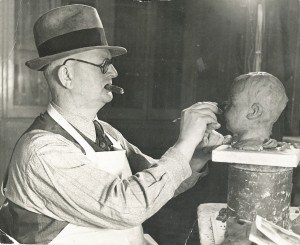 Publicity photo of Lipfert sculpting a doll’s head
Publicity photo of Lipfert sculpting a doll’s head
Linda I told you he was asked to be interviewed by Edward R. Morrow when he was first doing public television…when he first got started he wanted to interview my grandfather and he wouldn’t do it. The family was biting at the bit, but he was afraid because he had a bit of an accent and it was the times…he was not a…I mean he was OK in the company of friends… he would tell jokes you know…he was very …he wasn’t a shy man…
LYNN: But he wasn’t out looking for the attention.
Linda No, no not looking.
Lynn: Did he feel he was successful? I am getting the undercurrent that he was kind of surprised that there was this much attention paid to him.
Linda: His philosophy was money was to be enjoyed…you work hard and enjoy what you get and in that respect…they never had a maid in the house…they were nobody to do the yard work…he mowed the lawn, he trimmed the hedges there were very much old world in their thinking. He was happy.
Lynn: Did he think he was doing something special for children , or did he feel this was just a job?
Linda No, it wasn’t just a job…he enjoyed what he was doing. If he had his choice he would have liked to be a designer of figurines…(Linda: shows Lynn the last figurine she has) He liked porcelain sculpting.
Lynn: How did the rest of the family feel about his work and success?
My father and my grandfather were two different animals. My father was a tool and die maker and my grandmother… she always tells the tale of when they were back in Germany and it was Easter and she had him dressed up in a white sailor suit and she found him in the pig stye. He was a grease monkey when he was a teenager…you know…always under the car…fixing the car and I guess …my grandfather always wore…you know he always had a tye…a wool shirt…he was meticulous with the white shirt…always wore a white shirt…sent it to the Chinese laundry and he was meticulous that way…did not necessarily want to wear a suit, but when he went to work he dressed and he had an apron.
Lynn: Do you have brothers or sisters?
Linda: I have a brother out in Colorado and a sister.
Lynn: How did they feel about your grandfather?
Linda : It’s funny because my brother was the artistic one, so it was my father’s idea that he was going to send my brother over here when he was a teenager now I would have to ask my brother when at least when he was in tenth grade kind of apprentice him….grandpa was going to teach him how to sculpt Ha! My grandfather had him mix things, you know, but it wasn’t what my brother wanted to do so he wound up having him hanging out the window, painting the house…it did not last that long because it just was not a good idea…but it was my father’s idea that his grandfather was going to teach him how to be an artist.
My sister was much younger…I think she was a little afraid of my grandfather
But for me he would play cards with us, tell us good stories, take us to the park … I was probably closer to him than the other two.
Linda I remember both grandparents with fondness for what they taught me and how they valued me. It continues to amaze me that my grandfather practiced his craft until he was 80 and likewise my grandmother knit socks for my father until he died. I live in a house filled with very vibrant memories, to that end I wish that more people could have known the grandfather who sculpted dolls for generations past and present.
Bernard Lifpert died in his Westbury home on January 6, 1974.
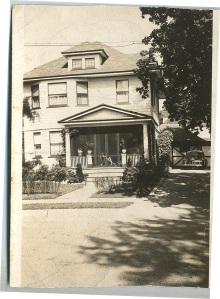
© April 2012 Lynn Nalven

